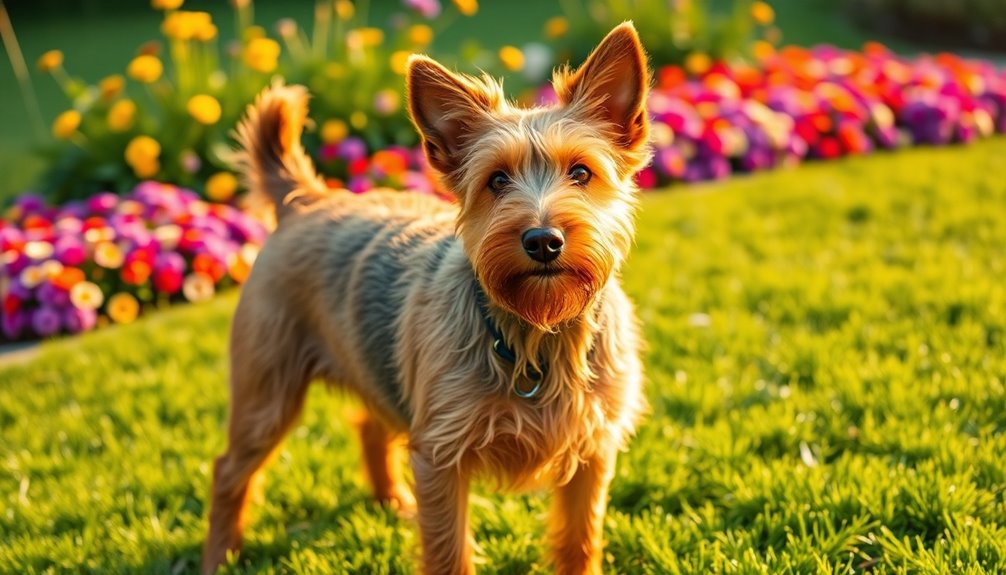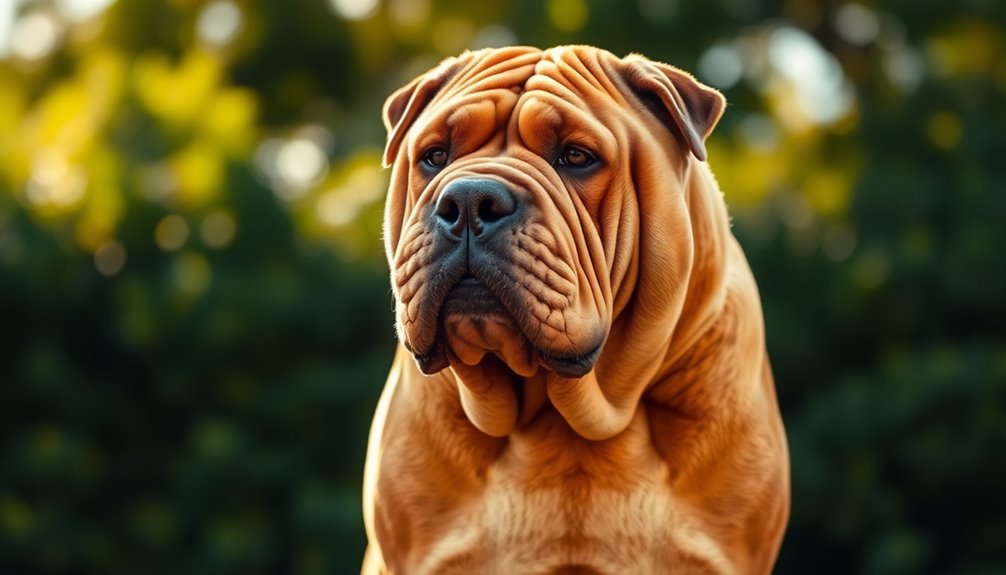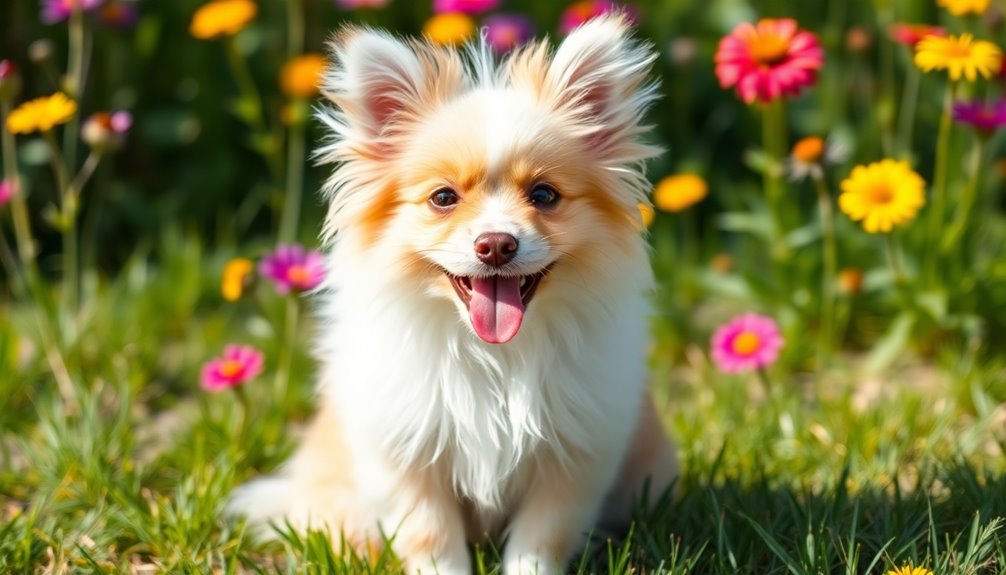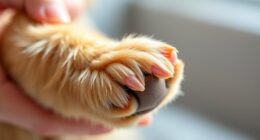The Lakeland Terrier is a lively and tenacious companion, perfect for an active lifestyle. Standing about 13.5 to 15 inches tall and weighing between 12 to 17 pounds, they're small but sturdy. Their bold and bright personality keeps things entertaining, and they thrive with at least 1 to 1.5 hours of daily exercise. Regular grooming helps maintain their wiry coat and overall health. Though they're great with families, proper socialization and training are essential to curb their strong prey drive. If you're curious about their history and care needs, there's plenty more to discover about these spirited dogs.
Key Takeaways
- Lakeland Terriers are spirited and playful, requiring regular mental and physical stimulation to stay happy and healthy.
- Their bold and fearless nature makes them excellent watchdogs, often wary of strangers.
- With a sturdy, wiry coat, they need consistent grooming to maintain their appearance and comfort.
- These dogs thrive in active households and can adapt well to urban living with proper exercise.
- Early training and socialization are essential to develop their confidence and good behavior around people and other pets.
Introduction
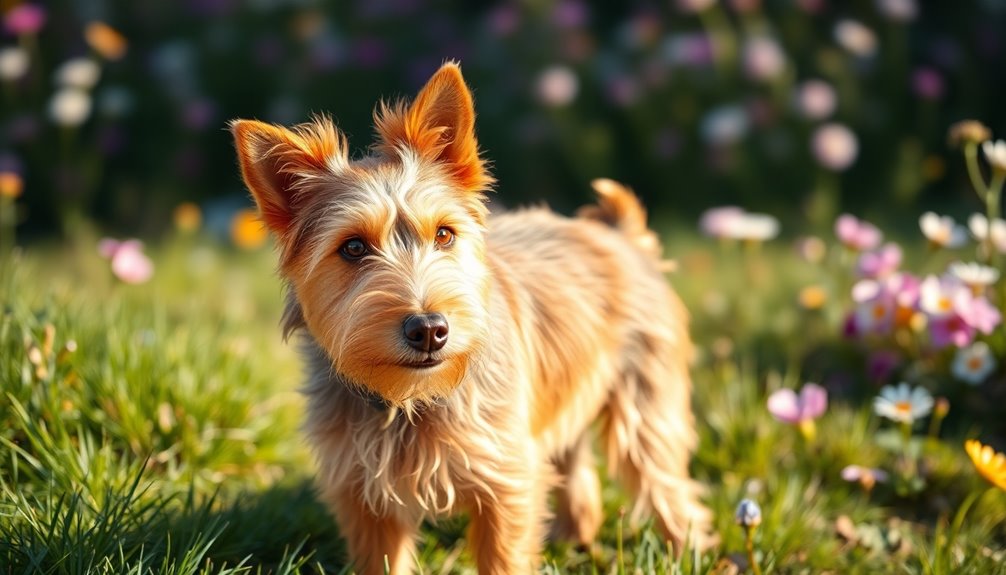
What makes the Lakeland Terrier such a beloved companion? This spirited breed stands out with its unique combination of physical characteristics and vibrant personality. Standing between 13.5 to 15 inches tall and weighing 12 to 17 pounds, they've got a compact and sturdy build. Their short, wiry double coat comes in a variety of striking colors, including black, blue, and red, making them visually appealing.
But it's their temperament that truly wins hearts. Bold, bright, and fearless, Lakeland Terriers are intelligent and inquisitive, always ready for an adventure. They're self-assured and energetic, bringing a playful, sometimes mischievous energy to your life. They require a minimum of 1 hour of exercise daily to maintain their high energy levels and prevent behavioral issues.
While they're good with children, their medium friendliness means supervision is key, especially given their tendency to chase wildlife due to their high prey drive.
Training can be a challenge due to their independent nature, so patience is essential. With a lifespan of 12 to 15 years, these low-shedding pups require regular exercise and a nutritious diet to thrive.
If you're seeking a loyal and lively companion, the Lakeland Terrier might just be the perfect fit for you!
History and Origin

The Lakeland Terrier originated in the rugged Lake District of Northern England during the 1700s, specifically in counties like Cumberland and Northumberland. Farmers relied on this breed for ratting and pest control, using their keen instincts to hunt down vermin in challenging terrain. Over time, their skills not only helped with pest management but also shaped their strong stamina and unique hunting style. The breed was initially developed for fox hunting, showcasing their speed and agility in the field.
Where and when the breed originated
Originating in the picturesque Lake District of Northern England, the Lakeland Terrier boasts a rich history that can be traced back to the 1700s. This lively breed hails specifically from the Cumberland area, near the Scottish border. It's named after the stunning Lake District, where it was closely associated with the fell packs in the region.
While its roots stretch back to the 18th century, the Lakeland Terrier began to develop more formally in the 1800s. By 1910, enthusiasts were discussing what they called the "new improved Fell Terrier," leading to the breed's name being agreed upon in 1912.
The formation of a breed association in 1921 further solidified its status. The Lakeland Terrier was influenced by several breeds, including the now-extinct Old English Black and Tan terrier, as well as the Welsh, Bedlington, Border, and Dandie Dinmont terriers.
Initially showcased at local agricultural events, it gained formal recognition and established breeding regulations in the early 20th century. The American Kennel Club recognized the breed in 1934, paving the way for its popularity in the United States. The breed's small size makes it an ideal companion for those living in apartments, as long as they meet its high energy and exercise needs.
Ratting and Pest Control
When it comes to pest control, Lakeland Terriers have a storied past as skilled ratters. Originating in the Lake District of northern England, these working terriers were initially bred to hunt foxes, otters, and badgers. Their agility and strong build made them perfect for pursuing prey deep into tunnels, allowing them to excel in pest control.
Since the 19th century, dogs like the Lakeland Terrier have been utilized for ratting, particularly during the Victorian era and even in World War I trenches. This ancient method isn't only effective but humane, as it allows dogs to kill rats quickly—often within seconds—avoiding the prolonged suffering associated with poisons. Their energetic nature is also a significant asset, enabling them to tirelessly track and chase down vermin.
With their dynamic nature, speed, and keen sense of smell, Lakeland Terriers are well-equipped for the task. They thrive in commercial settings, efficiently eradicating large numbers of rats while remaining well-natured around humans and other animals.
Today, companies like Vermicure and Project Multi-Pest rely on these trained terriers for comprehensive pest control, showcasing their continued relevance and effectiveness in modern pest management.
Physical Characteristics
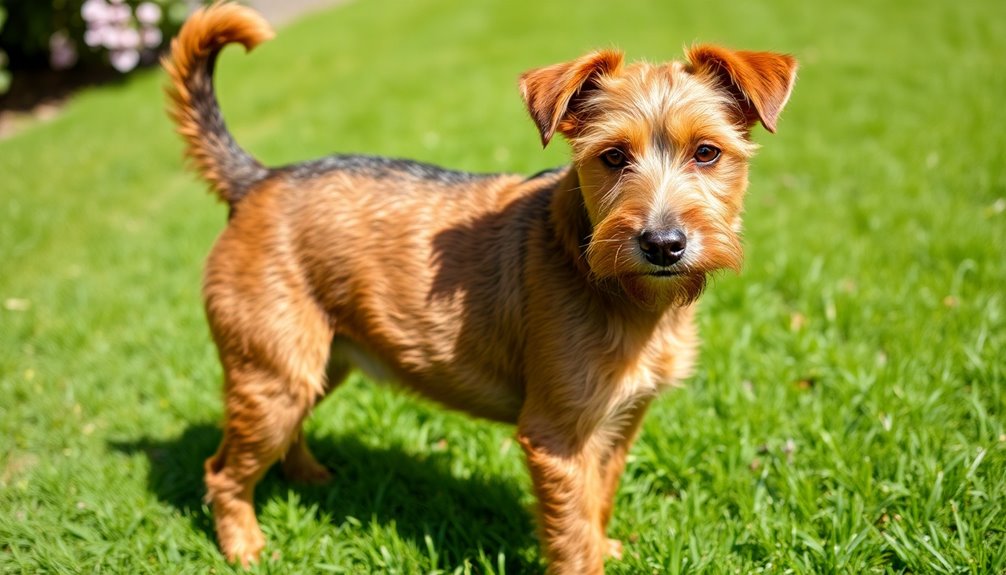
The Lakeland Terrier stands out with its sturdy, box-like shape and wiry double coat that can be straight or slightly wavy. Typically, males weigh around 17 pounds while females are slightly lighter at 15 pounds, with heights ranging from 13.5 to 15 inches. Their unique coat texture not only adds to their charm but also serves a practical purpose, providing protection in rocky environments. This breed's dense, harsh coat is also vital for ensuring their comfort and resilience in various weather conditions.
Size, weight, and coat details
Lakeland Terriers are compact and sturdy dogs, with males standing between 14.5 and 15 inches at the withers, while females are slightly smaller, ranging from 13 to 14 inches. This breed typically weighs around 17 pounds for males and about 15 pounds for females, placing them in a weight range of 15 to 18 pounds.
Their overall body length measures approximately 18 to 21 inches, showcasing their balanced and square build.
You'll notice that the Lakeland Terrier has a long-legged, sturdy physique that reflects its active nature. The breed's body profile is compact, allowing for free movement and agility. Additionally, their average lifespan of 12-16 years makes them a long-term companion for families.
With a broad muzzle and small, V-shaped ears, they've a distinct appearance. Their small, dark, oval eyes convey a lively expression, while their black nose and foot pads contribute to their charm.
These physical characteristics not only enhance their lively personality but also make them excellent companions. The combination of their size, weight, and sturdy build means they're well-suited for various activities, whether it's a casual walk or a spirited play session in the yard.
Coat Texture and Density
A Lakeland Terrier's coat is a defining feature that combines both texture and density to enhance its unique appearance. You'll notice the wiry outer coat, which is mildly coarse and dense, providing a rough yet appealing look. Beneath this, the soft undercoat sits close to the skin, ensuring that it doesn't overpower the wiry layer above.
The coat's density is deceptively thick, striking a balance that feels substantial without being overly profuse. The furnishings on the muzzle and legs are plentiful but neatly trimmed, adding to the breed's tidy aesthetic. The breed was historically developed for versatility in hunting, which is reflected in their strong and resilient coat.
Regular grooming is essential; you'll want to brush and comb your Lakeland's coat weekly to maintain its texture and appearance. Hand stripping is preferred for show dogs, as it preserves the coat's natural look, while clipping can alter both texture and color.
Specialized grooming techniques help keep the coat in top shape. Longer hair is left over the eyes, while areas like the skull and ears are trimmed smooth.
This grooming routine not only enhances your dog's looks but also protects against temperature fluctuations, making the Lakeland Terrier both a stylish and practical companion.
Temperament and Personality
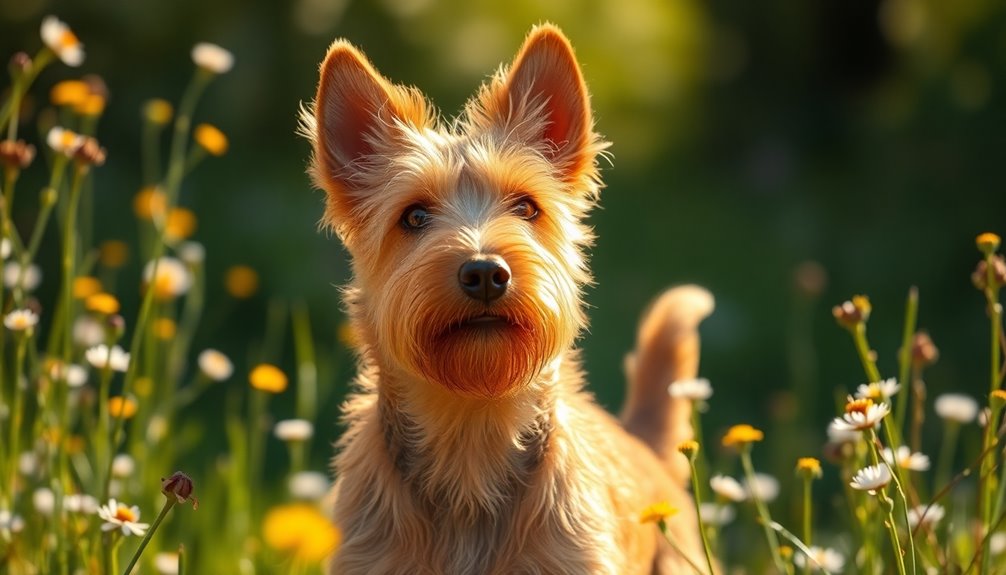
The Lakeland Terrier's playful and spirited nature makes it a delightful companion for both families and individuals. With their charming personality, they can fit well into various households, including those with other pets. However, their energetic temperament means they thrive best in active environments where they can engage and play regularly. To maintain their high energy levels, regular exercise and mental stimulation are essential for their overall well-being.
Playful and Spirited Nature
Although they may come off as small, Lakeland Terriers pack a playful and spirited personality that can light up any home. Their bold and confident nature means they're always ready for action, whether it's a game of fetch or a spirited chase around the yard.
You'll find that their high intelligence fuels their mischievous tendencies, keeping you on your toes with their clever antics. Regular exercise and mental stimulation can help reduce anxiety symptoms, allowing them to remain calm and focused.
These terriers are incredibly loyal and affectionate, forming strong bonds with their families. Their protective instincts can make them wary of strangers, but their vocal nature adds an amusing layer to their personality. Regular eye examinations are also essential due to their tendency toward certain eye conditions.
You'll appreciate their independent thinking, even if it leads to some stubbornness during training sessions.
To keep your Lakeland engaged, daily exercise and mental stimulation are essential. They thrive on active play and require regular opportunities to burn off energy.
Early socialization helps them develop good manners, allowing their spirited nature to shine in a friendly way. With consistent training and positive reinforcement, you'll manage their feistiness, channeling it into enjoyable experiences for both of you.
Suitability for families, individuals, or other pets
Lakeland Terriers are well-suited for families, individuals, and even some other pets, thanks to their adaptable and social nature.
They're particularly good with children, showing a patient and sweet demeanor that makes them great companions for families. Their loyalty and devotion to you and your loved ones are steadfast, though supervision is needed around very small kids due to their excitable nature. With an average lifespan of 12 to 15 years, they can become long-term family members who grow alongside your children.
For active individuals, Lakeland Terriers thrive in various living situations, including urban settings, as long as you provide plenty of exercise. Daily walks and play sessions keep them happy and healthy.
Their independent streak can lead to stubbornness, so consistent training and early socialization are essential.
When it comes to other pets, compatibility varies. While they can get along with other dogs if socialized properly, their strong prey drive makes them less suitable for homes with small animals like cats or rabbits.
If you're considering a Lakeland Terrier, be prepared for the need for supervision with smaller pets and be proactive about socialization from a young age. This way, you'll enjoy a harmonious home filled with joy and companionship.
Health and Lifespan
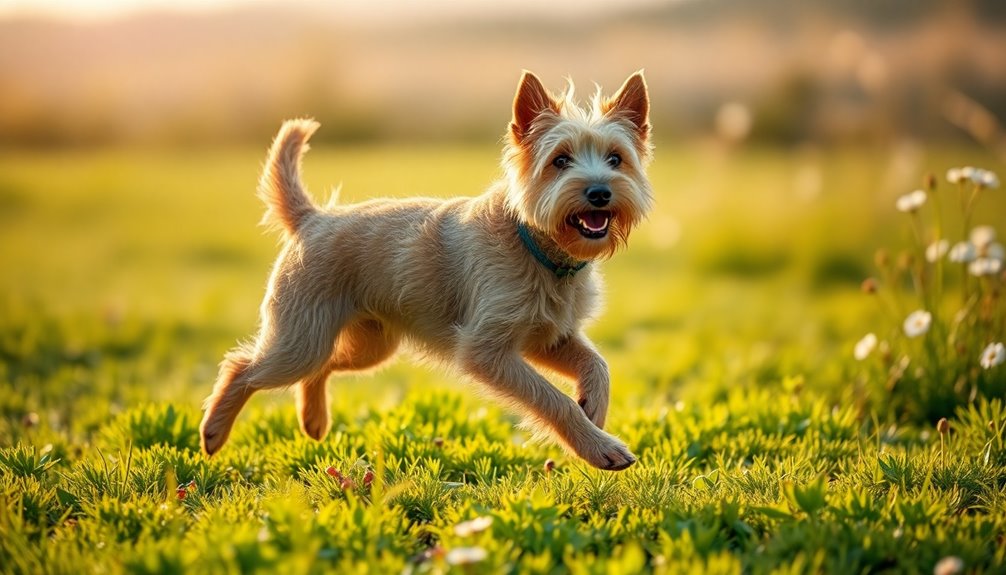
When it comes to your Lakeland Terrier's health and lifespan, understanding their typical lifespan of 10-12 years is essential. You should also be aware of common health concerns, such as dental disease and hip conditions, that can affect their quality of life. Regular veterinary check-ups are recommended to monitor health and ensure early detection of potential issues related to their selective breeding.
Typical lifespan of the breed
Understanding the typical lifespan of a Lakeland Terrier can help you prepare for the years ahead with your furry companion. Generally, these lively dogs live between 12 to 15 years, but some can reach up to 16 years or even longer. It's not uncommon for exceptionally healthy individuals to live as long as 17 or 18 years, thanks to their robust nature.
Several factors influence their lifespan. Proper care and nutrition are crucial, so make sure to provide a balanced diet tailored to your dog's age, weight, and activity level. Regular veterinary check-ups also play a significant role in catching health issues early, including common health problems that may arise in the breed.
Don't forget that adequate exercise and mental stimulation can enhance their well-being and longevity.
As your Lakeland Terrier ages, you might notice the onset of old age around the age of 10. Look for signs like stiffness, lower energy, or changes in eating habits. While grey hairs may not be as noticeable around their muzzle, energy levels usually remain high until later in life.
Keeping your dog active and engaged can help maintain their vitality throughout their years together.
Common health concerns or genetic predispositions
Several common health concerns can affect Lakeland Terriers, and being aware of these issues can help you provide better care for your furry friend.
Dental disease is a major concern due to their small size, leading to tartar buildup and potential tooth loss. Regular dental cleanings and daily brushing are essential, especially if your dog has an underbite, which can exacerbate issues.
Musculoskeletal problems, while less frequent, may include Legg-Calvé-Perthes disease, a bone disorder requiring surgery. Keep an eye out for any signs of discomfort or lameness. Routine veterinary check-ups are crucial for monitoring health and catching any potential issues early on.
Eye disorders like cataracts and distichiasis are also potential concerns, especially in older dogs. Regular eye exams by the Canine Eye Registration Foundation (CERF) can help catch these issues early.
General health issues such as hypothyroidism and cryptorchidism can occur, along with the rare von Willebrand's disease, a genetic bleeding disorder.
Additionally, chronic allergies leading to itchy skin and bacterial infections can affect your Lakeland Terrier. Staying informed about these health risks will empower you to take proactive steps in your dog's care.
Tips for maintaining health and wellness
Maintaining the health and wellness of your Lakeland Terrier is essential for a long, happy life. Start by feeding them a high-quality, balanced diet tailored to their size, age, and activity level. Consult your veterinarian to determine the right amount and type of food, and always provide fresh water.
Be cautious with treats to prevent overfeeding, and avoid home-cooked blends without professional advice.
Ensure your Lakeland gets at least an hour of exercise daily, whether it's long walks, jogs, or playing fetch. Engage them in dog sports like tracking and agility for added mental stimulation. Keep their strong prey drive in check by using a leash or a securely fenced area. The Lakeland Terrier's strong prey drive can make it essential to provide regular mental challenges to keep them engaged.
Groom your dog regularly by brushing their coat weekly and hand-stripping occasionally to maintain texture. Bathe them every four to six weeks and keep their ears clean.
Regular veterinary checkups are vital for health monitoring, and maintain a grooming routine to catch any potential skin issues early. Lastly, keep an eye on signs of aging, like stiffness or changes in eating habits, to ensure your furry friend stays healthy and active.
Care Requirements
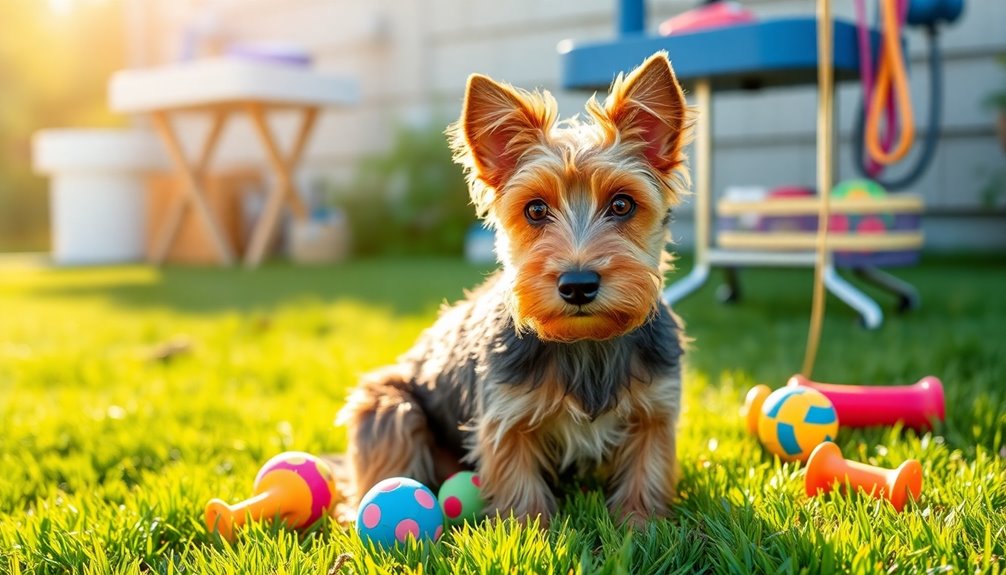
Caring for your Lakeland Terrier involves regular hand-stripping to maintain their wiry coat, along with ensuring they get plenty of exercise to match their high energy levels. You'll need to provide about 1 to 1.5 hours of activity each day, which could include walks, playtime, and engaging games. Additionally, a balanced diet tailored to their age and energy needs is essential for their overall health and well-being. Regular vet check-ups are also important to monitor for breed-specific health issues.
Regular Hand-Stripping Required
To keep your Lakeland Terrier looking its best, regular hand-stripping is essential. This technique involves removing dead hair by hand or with a stripping knife, allowing you to maintain the breed-standard wire coat. It's crucial to follow a regular schedule for hand-stripping, as it strengthens the coat's quality and texture. Emotional disconnection can occur if grooming is neglected, leading to potential issues in the bond you share with your dog.
Typically, you'll strip the outer layer while systematically raking the undercoat. You'll want to incorporate weekly brushing and combing to remove dead hair and stimulate new growth. To maintain that signature harsh texture and vibrant color, rolling the coat weekly is also important. Additionally, their high energy level means that consistent grooming can also serve to strengthen the bond between you and your dog through shared activity.
Depending on your dog's lifestyle, consider monthly baths for the leg and facial furnishings. While clipping is a common alternative, it results in a softer, bushier coat and requires different grooming techniques. If you choose to clip, use #10 or #8 1/2 blades, but keep in mind that clipped coats still demand regular maintenance to prevent matting.
Regardless of your grooming choice, regular care helps in early detection of skin issues, ensuring your Lakeland remains healthy and looking great.
Exercise requirements and energy levels
Grooming your Lakeland Terrier goes hand in hand with meeting their exercise needs and managing their energy levels. You'll need to provide about 1 to 1.5 hours of exercise each day to keep your pup happy and healthy. Daily walks, playtime in securely fenced areas, and interactive games are essential to maintain their medium to high energy levels.
Engage your Lakeland in long walks, jogs, hikes, or vigorous games of fetch, as they thrive on physical and mental stimulation. They also excel in dog sports like agility and obedience trials, which can be a fun way to bond while giving them the activity they crave. Their robust physique allows them to participate in a variety of activities without becoming easily fatigued.
Keep in mind their strong prey drive—always use a leash or ensure that any outdoor area is securely fenced.
To prevent boredom and destructive behaviors, incorporate engaging activities that promote mental sharpness. Their high playfulness means interactive games are crucial, so make time for those fun sessions.
Feeding tips and diet recommendations
Feeding your Lakeland Terrier requires attention to their specific nutritional needs to keep them healthy and energetic. Start by providing high-quality protein from animal sources like beef, chicken, and fish. This protein is essential for muscle maintenance and overall health, helping to prevent issues like obesity and joint problems. A natural diet that includes raw food can significantly improve their digestive health and overall vitality.
Balanced fats are equally important; they supply energy and support a healthy coat. Look for a mix of saturated and unsaturated fats to maintain optimal energy levels.
You can include small amounts of carbohydrates from plant-based sources like vegetables and berries, which provide fiber and essential nutrients. If your dog has food sensitivities, consider grain-free options to avoid allergies.
It's crucial to control portions by splitting daily food intake into two meals. This helps prevent overeating and keeps your Lakeland Terrier at a healthy weight. Ensure fresh water is always available for hydration.
Regularly assess your dog's weight and limit treats to avoid excess calories. If you opt for a raw food diet, use a raw food calculator to determine appropriate portions.
Following these tips will ensure your Lakeland Terrier stays vibrant and active!
Training and Socialization
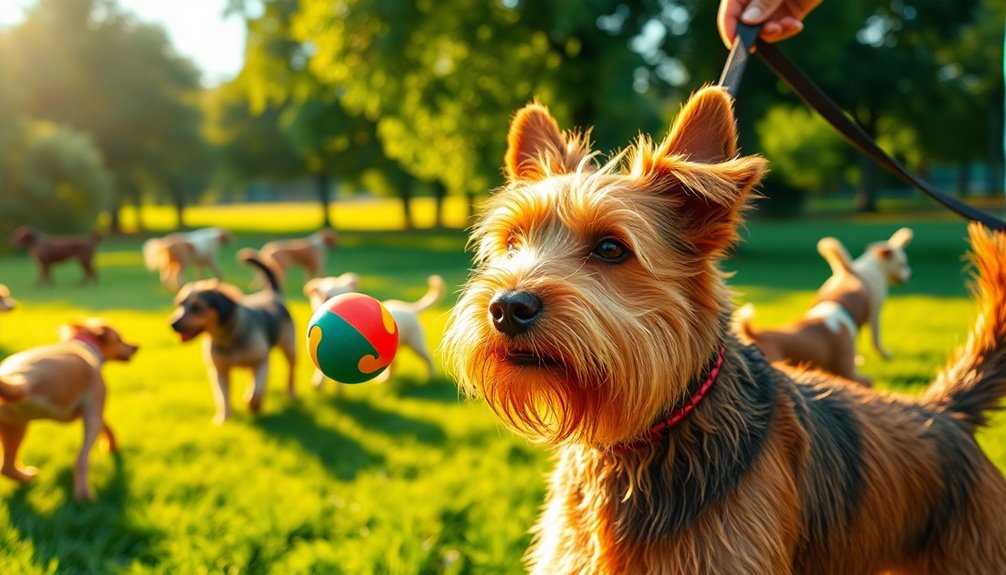
Training your Lakeland Terrier requires consistency and patience, as these dogs are intelligent yet can be strong-willed. Gradually introducing them to new environments will help reduce leash reactivity during walks and foster a more confident companion. Additionally, engaging in agility training can provide both physical and mental stimulation, further enhancing their obedience and focus. Incorporating effective relaxation techniques can also help manage their energy levels and promote a calmer demeanor.
Moderate Intelligence, Requires Consistency
How can you effectively harness the intelligence of a Lakeland Terrier while managing their independent streak? Start by understanding that these dogs are remarkably intelligent and quick learners, but they can also be stubborn. Early training is crucial, so begin during puppyhood to set the stage for good behavior and clear expectations.
Focus on basic obedience commands first, and then gradually introduce more complex tasks. Use positive reinforcement—treats and praise work wonders to motivate them. Keep training sessions short and engaging to maintain their attention, and incorporate variety to keep things interesting. They are a vulnerable native breed, making proper training even more important for ensuring their well-being.
They thrive on mental stimulation, so mix up your approach to prevent boredom. Consistency is essential. Establish a routine and stick to it, as Lakeland Terriers need firm guidance to navigate their independent nature.
Gradual Introductions to New Environments
Introducing your Lakeland Terrier to new environments should be a gradual process to ensure their comfort and confidence. Start by familiarizing them with your home and backyard. Introduce small changes like new toys or blankets, and play soothing music to create a calming atmosphere. Reward their calm behavior with treats and praise, allowing them to explore at their own pace.
Once your dog is comfortable at home, begin to introduce them to new environments, starting with quiet areas like less crowded parks or pet-friendly stores. Observe their reactions and adjust based on their comfort level. Use familiar toys or games to engage them in these new surroundings, and keep initial visits short. If your dog shows signs of discomfort, retreat to quieter spots.
Utilize positive reinforcement techniques by pairing new experiences with high-value treats. This safe exposure is crucial for reducing anxiety and helping them adapt to unfamiliar situations. Praise and pet your dog when they display relaxed behavior, and let them approach new people or dogs at their own pace. Avoid forcing interactions, and instead, create positive associations with these experiences to build their trust and confidence in the world around them.
Leash Reactivity During Walks
Leash reactivity can turn what should be an enjoyable walk into a stressful ordeal for both you and your Lakeland Terrier. This intense reaction to stimuli, like other dogs or people, often stems from anxiety or frustration. Your dog may show signs of being over threshold, such as growling or lunging, making walks feel tense.
To manage leash reactivity, start by rewarding your dog for making eye contact with you. This helps redirect their focus. If you notice a trigger approaching, use U-turns to change direction and create distance, keeping your dog under threshold. Additionally, maintaining a safe distance from other dogs can significantly minimize your dog's stress during walks.
Desensitization is crucial; gradually expose your dog to triggers while rewarding calm behavior. Stay calm yourself during walks, as your energy influences your dog. Keep the leash relaxed to avoid escalating reactivity, and avoid jerking the leash, which can cause harm.
Incorporate training techniques like clicker training and the lure-and-reward method to reinforce desired behaviors. Remember, patience is key. With consistent practice, you can help your Lakeland Terrier enjoy walks without the stress of reactivity.
Ideal Living Environment
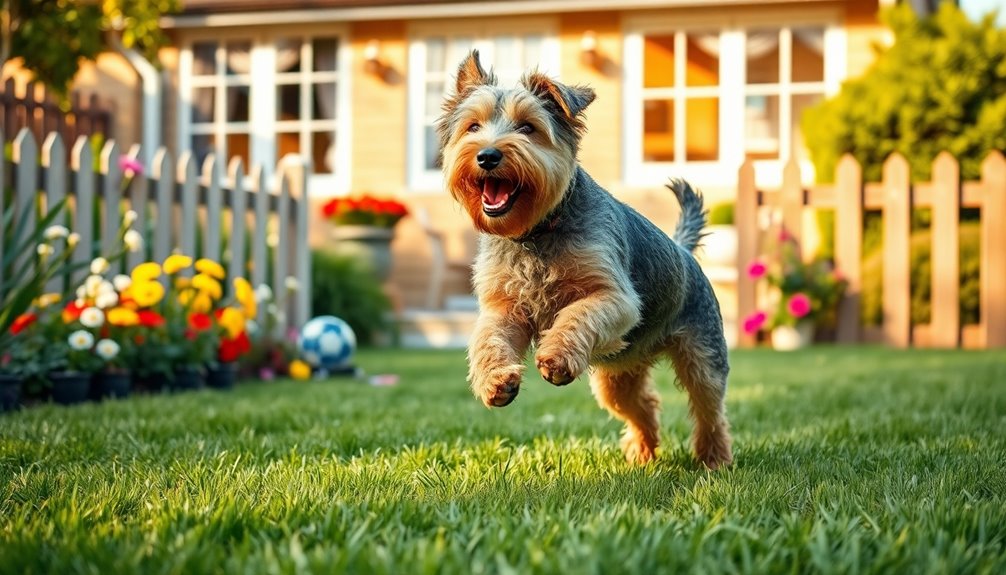
If you live in an urban apartment, a Lakeland Terrier can be a perfect fit, especially if you're close to parks for daily exercise. They thrive in moderate temperatures, so ensure your living space offers comfort year-round. Just remember, regular outdoor activity is essential to keep your energetic companion happy and healthy. Additionally, their high energy levels necessitate daily mental stimulation and engaging activities to keep them entertained. Incorporating consistent routines into their daily schedule can also help reinforce positive behaviors and improve their overall well-being.
Urban Apartment With Nearby Parks
Living in an urban apartment with nearby parks is an excellent choice for a Lakeland Terrier, as long as you meet their exercise and socialization needs. These energetic dogs thrive in smaller spaces when you provide sufficient physical activity. Daily brisk walks, jogs, or runs around your neighborhood are essential to keep them happy and healthy. Additionally, they require a confident pack leader to help them succeed in their urban environment, preventing the development of Small Dog Syndrome.
You won't need a yard, but make sure you engage them in indoor play and mental stimulation. Activities like catch, agility training, and brain games will keep their minds sharp and their energy levels in check. Just be mindful that they can be noisy if not properly trained, so consistent, patient training is crucial.
Your Lakeland will love the chance to run off-leash in safe areas, so frequent visits to nearby parks will be a win-win. Ensure they're well-socialized with other dogs and animals during these outings.
With a confident training approach and plenty of exercise, your Lakeland Terrier can adapt perfectly to urban living. Embrace the experience together, and you'll both enjoy the benefits of city life!
Prefers Moderate Temperature Ranges
Urban environments can present challenges for your Lakeland Terrier, particularly regarding temperature management. These dogs thrive in moderate temperature ranges, typically between 60 and 75 degrees Fahrenheit. When temperatures rise above 81 degrees, your Lakeland may start showing signs of overheating, so it's essential to monitor their behavior closely. Panting serves as the primary cooling mechanism for your dog, so be attentive to their breathing patterns during hot weather.
Ensure they've access to shade and fresh water during hot days.
On chilly days, your Lakeland's double coat provides insulation, but they still need a warm, cozy spot to retreat. They breathe through their nose to retain heat, so keep their indoor environment comfortable.
Regular grooming helps maintain their coat's insulating properties, allowing them to adapt to various climates.
Exercise is crucial, but you should adjust the intensity based on the weather. In hot weather, opt for early morning or later evening walks, while in colder months, ensure they stay active without overexerting.
Unique Coat Color Variations
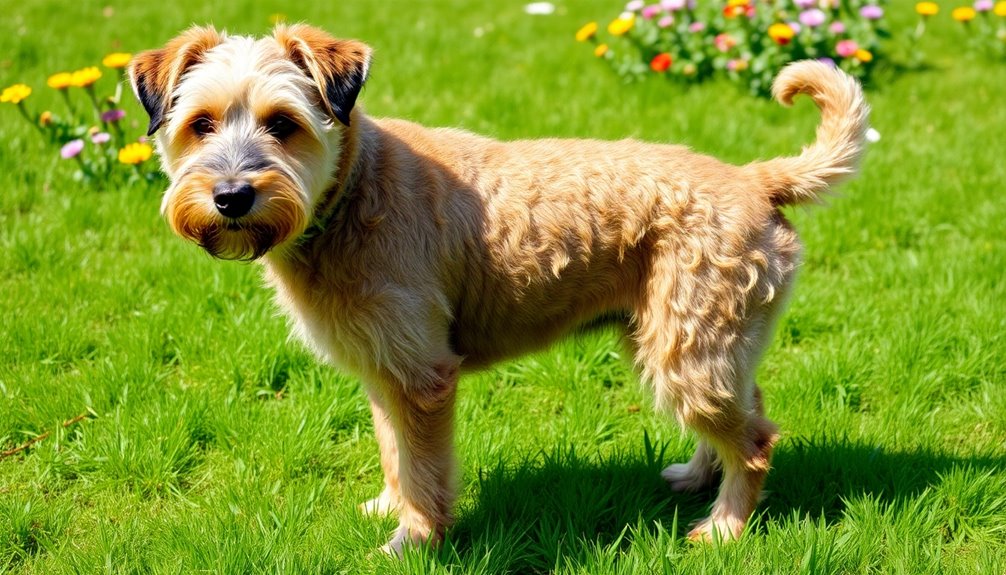
When you watch dog shows, you might notice that certain Lakeland Terrier coat color variations are rarely seen on the stage.
These unique colors not only set these dogs apart but also add to their charm, as seen in the famous Lakeland Terrier from film. Understanding these variations can deepen your appreciation for this special breed. Their narrowest band of color among wire-coated, long-legged Terrier breeds adds to the grooming challenges faced by owners and handlers alike.
Rarely Seen in Dog Shows
The unique coat color variations of Lakeland Terriers often make them a rare sight in dog shows. While you might encounter solid colors like black, blue, liver, red, and wheaten, the more striking saddle-marked combinations of black and tan or blue and tan are less common.
The challenge increases with grizzle patterns, which can change as the dog matures. Rare combinations, such as blue and tan saddle-marked Lakelands, are typically chalked black for presentation, complicating their appearance in the ring.
Grooming is another hurdle. The narrow band of color in their coats makes it tough to achieve consistent coloration. Clippered coats can lighten over time, and meticulous grooming with colored chalk is essential.
To maintain an even look, you may find yourself plucking hair by hair, especially in solid blue variations.
Judges need to understand these unique colors and the challenges that come with them. Tail and ear characteristics, along with proper head structure, also play a significant role in how your Lakeland performs.
Ultimately, the combination of rarity and grooming challenges contributes to their infrequent appearances at dog shows.
Famous Lakeland Terrier in Film
Lakeland Terriers have made memorable appearances in film and media, showcasing their unique coat color variations and charming personalities.
One standout in the dog show world was Stingray of Derryabah, the first dog to win Best in Show at both Westminster and Crufts. His achievements set a historic milestone, representing the breed's excellence and potential for top honors.
Another notable figure is Zelda Van Gutters, who served as Nickelodeon Magazine's Roving Reporter. Her engaging public appearances helped popularize the breed among younger audiences, embodying the friendly and outgoing nature of Lakeland Terriers.
Champion Revelry's Awesome Blossom, owned by Jean L. Heath and Bill Cosby, also showcased the breed's appeal to celebrities, participating in numerous competitions. Similar to the quirky characters that appear in Christopher Guest's "Best in Show," these Lakeland Terriers have captured the hearts of many.
What makes Lakeland Terriers particularly captivating are their unique coat colors, including blue, black, liver, red, wheaten, red grizzle, and liver and tan. Each color variation requires meticulous grooming to maintain their striking appearance.
Whether they're strutting their stuff in dog shows or charming audiences in media, Lakeland Terriers continue to shine, proving their place in both culture and hearts.
Active Lifestyle Compatibility?
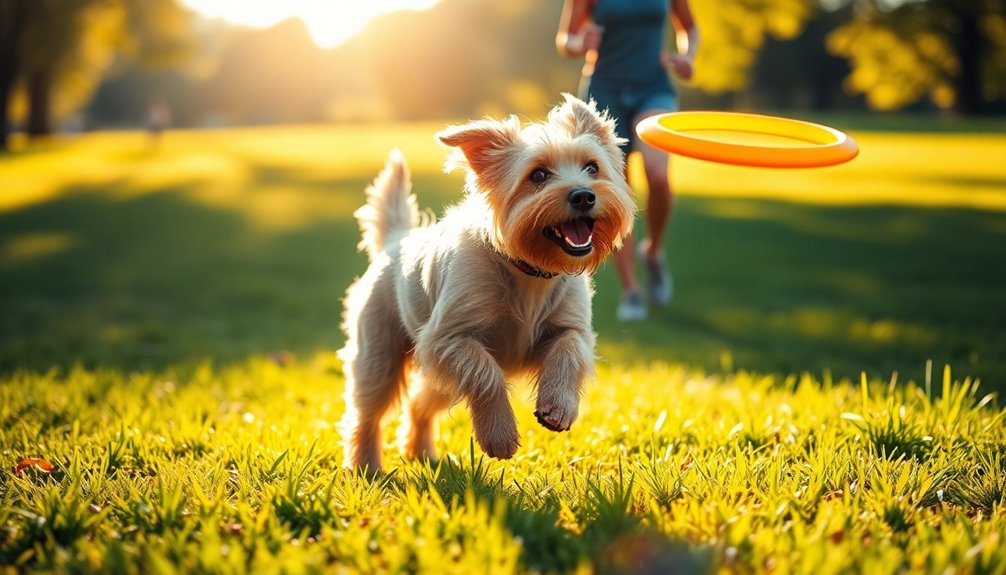
If you lead an active lifestyle, a Lakeland Terrier could be the perfect companion for you. These energetic dogs thrive on regular exercise and enjoy activities like agility courses and fetch. Just be prepared for their grooming needs, as maintaining their distinctive coat requires some commitment. Additionally, they have a high energy level that makes them suitable for active households, ensuring they stay engaged and happy.
Ideal for Active Individuals
Embrace an active lifestyle with a Lakeland Terrier by your side, as these spirited companions thrive on energetic adventures. With daily exercise requirements of 1 to 1.5 hours, you'll find plenty of opportunities to keep both you and your dog engaged. Enjoy daily walks, vigorous runs, and fun games like fetch and tug-of-war to keep their energy levels in check.
Lakeland Terriers are perfect for active families who love outdoor activities. They excel in dog sports such as agility and obedience trials, making them versatile companions for your adventures. Whether you're hiking or playing in a securely fenced area, they'll match your enthusiasm.
These dogs also need mental stimulation, so mix in puzzle toys and training sessions to keep their minds sharp. Remember, they've a strong prey drive and benefit from consistent recall training and socialization.
Whether you live in a bustling city or a spacious home, Lakeland Terriers adapt well, provided they've secure spaces to explore. By incorporating varied activities into your routine, you'll ensure a happy, balanced life for your energetic friend.
Grooming Needs and Maintenance
Maintaining a Lakeland Terrier's coat requires commitment, especially for active individuals who want to keep their energetic companion looking its best.
You'll need to brush your dog's coat weekly to remove loose fur and dirt. Hand-stripping is essential to preserve the coat's texture and color, while clipping can soften the coat but may reduce its weather-resistance. A combination of both methods can help maintain vibrancy and eliminate dead hair. The grooming process often includes hand-stripping, which is recommended for optimal coat maintenance.
The Lakeland Terrier boasts a harsh, double coat with a wiry topcoat and a soft undercoat, so regular grooming prevents matting. Raking the undercoat is crucial for optimal health.
Bathe your dog every four to six weeks, adjusting for their activity level. You might need monthly baths for the legs and face. Weekly ear checks and daily teeth brushing are also vital, with nail trims about once a month.
For allergy sufferers, Lakeland Terriers are a suitable choice, as they're considered non-shedding. Proper grooming reduces dander and helps monitor any potential health issues related to the coat.
Frequently Asked Questions
How Much Do Lakeland Terriers Typically Weigh?
Lakeland Terriers typically weigh between 15 to 17 pounds when fully grown.
Males usually weigh around 17 pounds, while females tend to be slightly lighter, averaging 15 to 16 pounds.
You'll notice that their weight can vary somewhat, but generally, females are on the smaller side.
It's important to keep their weight in check, as a healthy weight contributes to their overall well-being and energetic lifestyle.
Are Lakeland Terriers Good With Children?
Yes, Lakeland Terriers can be good with children, especially if you supervise their interactions.
They're generally friendly and enjoy playful moments, but they're best suited for families with older, respectful kids.
You should start socializing your Lakeland early to help them bond well with your children.
Keep in mind they've a lot of energy, so monitor playtime to ensure everyone stays safe and has fun together.
What Is the Average Lifespan of a Lakeland Terrier?
The average lifespan of a Lakeland Terrier ranges from 12 to 16 years, with some living up to 17 or 18 years. This lifespan is relatively high compared to many pedigree breeds.
To help your Lakeland thrive, regular vet check-ups are essential, and you should provide a healthy environment and lifestyle.
Keep them fit and mentally stimulated to enhance their longevity, while being aware of signs of aging like stiffness or changes in energy levels.
Do Lakeland Terriers Shed a Lot?
No, Lakeland Terriers don't shed a lot. They're known for their minimal shedding, which makes them a good choice for allergy sufferers.
To keep their coat healthy, you'll want to brush them weekly for about 20-30 minutes. Regular grooming, including hand-stripping, helps manage any loose hair and maintains their unique coat texture.
While no dog is completely hypoallergenic, you'll find this breed sheds less than many others.
How Much Exercise Does a Lakeland Terrier Need Daily?
A Lakeland Terrier needs about 1 to 1.5 hours of exercise daily.
You should include daily walks, varying routes to keep things interesting. Engage in playtime in secure areas and interactive games like fetch or tug of war.
As your dog matures, brisk walks, jogs, and hikes become beneficial.
Don't forget mental stimulation with puzzle toys or training sessions to keep their intelligent minds engaged and prevent boredom.
Conclusion
In conclusion, the Lakeland Terrier makes a lively and tenacious companion for those ready to embrace their spirited nature. With a rich history and a unique coat, they bring joy and energy to any home. Their playful personality and loyalty make them perfect for active lifestyles, while proper training and socialization ensure they thrive. If you're looking for a devoted friend who's always up for an adventure, the Lakeland Terrier might just be your ideal match!

